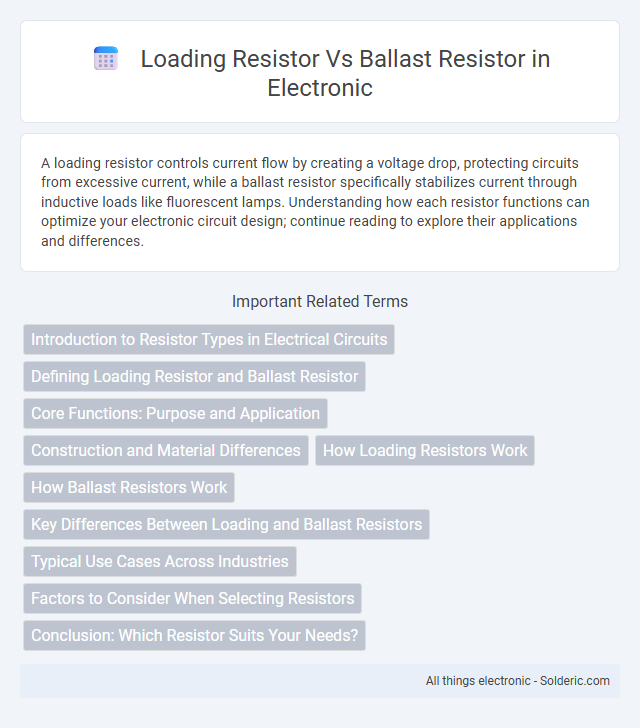A loading resistor controls current flow by creating a voltage drop, protecting circuits from excessive current, while a ballast resistor specifically stabilizes current through inductive loads like fluorescent lamps. Understanding how each resistor functions can optimize your electronic circuit design; continue reading to explore their applications and differences.
Comparison Table
| Feature | Loading Resistor | Ballast Resistor |
|---|---|---|
| Primary Function | Limits current by adding load to the circuit | Stabilizes current and protects against current surges |
| Typical Applications | Voltage division, signal conditioning | Fluorescent lamps, LED circuits, transistor biasing |
| Operation Principle | Consumes power, causing voltage drop to regulate current | Provides negative temperature coefficient to stabilize current |
| Resistance Value | Fixed, calculated for specific load requirements | Often designed with temperature-dependent characteristics |
| Heat Dissipation | Generates heat proportional to current and resistance | Generates heat but self-regulates to prevent excess current |
| Effect on Circuit Efficiency | Reduces efficiency due to power loss | Improves device longevity by preventing current spikes |
| Example Components | Fixed resistors, potentiometers | NTC/PTC thermistors, specialized resistors |
Introduction to Resistor Types in Electrical Circuits
Loading resistors and ballast resistors serve distinct roles in electrical circuits; loading resistors primarily manage current flow by providing a specific resistance to simulate electrical loads, while ballast resistors regulate voltage and limit current to protect components like LEDs and fluorescent lamps. Loading resistors are often used in testing and signal conditioning to ensure proper functioning of circuit elements under load conditions. Ballast resistors improve circuit stability by preventing current surges and maintaining consistent operation in devices sensitive to voltage fluctuations.
Defining Loading Resistor and Ballast Resistor
A loading resistor is an electrical component used to simulate a specific load in a circuit, ensuring proper operation by maintaining current flow and voltage levels. A ballast resistor is designed to limit current in devices like fluorescent lamps or automotive ignition systems, preventing excessive current that could damage the circuit. Both resistors serve distinct purposes: loading resistors stabilize signal conditions during testing, while ballast resistors protect sensitive components by regulating current.
Core Functions: Purpose and Application
A loading resistor primarily serves to simulate the electrical load of a device, ensuring proper current flow and voltage levels in circuit testing or LED applications. Ballast resistors regulate and limit current in fluorescent lamps or ignition systems, preventing damage from excessive current and stabilizing the operation. Both resistors play crucial roles in managing current but differ in their specialized applications and specific operational goals within electrical circuits.
Construction and Material Differences
A loading resistor is typically constructed from carbon film or metal oxide materials designed to dissipate electrical energy by converting it into heat, often featuring a simple cylindrical shape with axial leads. Ballast resistors often use wire-wound construction to handle higher power dissipation and improve durability under fluctuating current conditions, frequently incorporating ceramic cores to enhance heat resistance. The fundamental material choice and physical design in ballast resistors enable precise current regulation, whereas loading resistors emphasize consistent resistance under steady loads.
How Loading Resistors Work
Loading resistors work by creating a controlled electrical load on a circuit to simulate real operating conditions and stabilize voltage levels. They draw a specific current to prevent system errors or misreadings, especially in LED lighting or indicator systems. Your circuit benefits from consistent performance and avoids issues like flickering or false alerts through the proper use of loading resistors.
How Ballast Resistors Work
Ballast resistors regulate current flow by providing a stable resistance that limits excessive current in circuits, protecting components like transistors or LEDs from damage. Unlike simple loading resistors that primarily reduce voltage or current load, ballast resistors adjust their resistance in response to temperature changes, preventing overheating and ensuring consistent performance. This self-regulating property enhances circuit reliability by maintaining current within safe operating limits under varying conditions.
Key Differences Between Loading and Ballast Resistors
Loading resistors primarily serve to simulate electrical loads or limit current in circuits, ensuring stable voltage levels under varying conditions. Ballast resistors specifically regulate current flow in devices like fluorescent lamps or ignition systems, preventing excessive current that could damage components. Key differences include their functional roles, with loading resistors managing voltage stabilization in general circuits and ballast resistors focusing on current control and protection in specialized applications.
Typical Use Cases Across Industries
Loading resistors are commonly used in electronic testing and measurement to simulate real-world electrical loads, ensuring accurate circuit performance evaluations. Ballast resistors find extensive applications in automotive ignition systems and LED lighting to regulate current and protect components from damage. Your selection between these resistors depends on the specific industry requirements for current control and circuit stability.
Factors to Consider When Selecting Resistors
When selecting between a loading resistor and a ballast resistor, consider the specific application requirements such as voltage drop, power dissipation, and current regulation. Loading resistors are ideal for simulating loads or controlling signal levels, while ballast resistors are designed to limit current in devices like fluorescent lamps or LEDs. Your choice should prioritize resistor power rating, thermal stability, and the resistor's impact on circuit performance to ensure reliable operation.
Conclusion: Which Resistor Suits Your Needs?
Choosing between a loading resistor and a ballast resistor depends on your specific application requirements. Loading resistors are ideal for stabilizing signal circuits by simulating the expected load, while ballast resistors excel in limiting current to protect components in high-intensity discharge lighting or LED systems. Your selection should consider factors like desired current regulation, heat dissipation, and compatibility with the electrical system for optimal performance.
loading resistor vs ballast resistor Infographic

 solderic.com
solderic.com